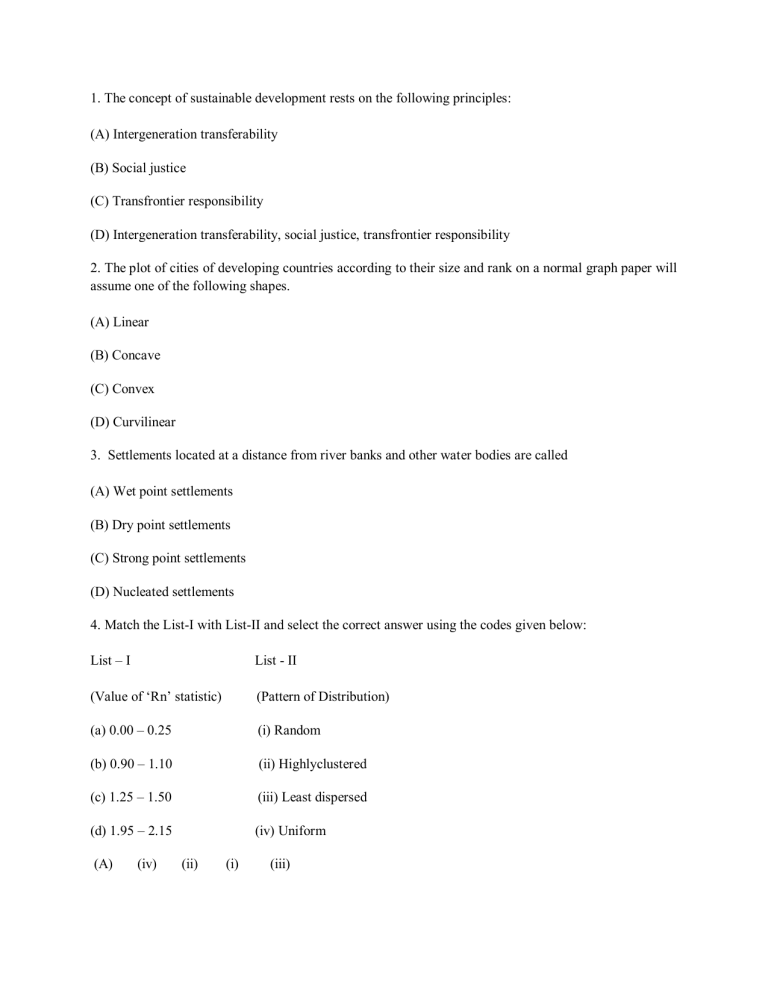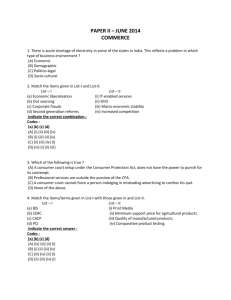
1. The concept of sustainable development rests on the following principles: (A) Intergeneration transferability (B) Social justice (C) Transfrontier responsibility (D) Intergeneration transferability, social justice, transfrontier responsibility 2. The plot of cities of developing countries according to their size and rank on a normal graph paper will assume one of the following shapes. (A) Linear (B) Concave (C) Convex (D) Curvilinear 3. Settlements located at a distance from river banks and other water bodies are called (A) Wet point settlements (B) Dry point settlements (C) Strong point settlements (D) Nucleated settlements 4. Match the List-I with List-II and select the correct answer using the codes given below: List – I List - II (Value of ‘Rn’ statistic) (Pattern of Distribution) (a) 0.00 – 0.25 (i) Random (b) 0.90 – 1.10 (ii) Highlyclustered (c) 1.25 – 1.50 (iii) Least dispersed (d) 1.95 – 2.15 (iv) Uniform (A) (iv) (ii) (i) (iii) (B) (ii) (i) (iii) (iv) (C) (i) (ii) (iii) (iv) (D) (ii) (iv) (i) (iii) 5. Which one of the following distances does not fit into Christaller’s scheme of k = 3 hierarchy of central places? (A) 7 (B) 11 (C) 21 (D) 36 6. Match List-I with List-II and select the correct answer from the codes: List – I List - II (a) Ranchos 1. India (b) Favelas 2. Brazil (c) Kavettits 3. Venezuela (d) Bustee 4. Myanmar (A) 2 3 1 4 (B) 3 2 4 1 (C) 1 2 3 4 (D) 4 2 3 1 7. Assertion (A): Annual growth rate of population in developed nations is much lower than in developing nations. Reason(R): Economic development results in reduction in birth rate Codes: (A) Both (A) and (R) are correct and (R) explains (A). (B) Both (A) and (R) are correct, but (R) does not explain (A). (C) (A) is true, but (R) is false. (D) (A) is false, but (R) is true. 8. Which one of the following statements is not correct about migration? (A) Migration varies inversely with the distance between source and destination. (B) The majority of migrants move in order to improve their economic conditions. (C) Governments create migration policies to attract the talents that they lack. (D) Women tend to move longer distances than men. 9. Match the List-I with List-II and select the correct answer using the categories below: (a) Post neonatal mortality age (i) Less than 28 days (b) CMR age (ii) Less than one year (c) Neonatal mortality age (iii) 28 days – 364 days (d) IMR age (iv) Less than five years (A) (iii) (iv) (ii) (i) (B) (iv) (iii) (i) (ii) (C) (iii) (iv) (i) (ii) (D) (i) (ii) (iii) (iv) 10. Which of the following sets of countries does not use coal as essential energy for industries? (A) Poland and Switzerland (B) Switzerland and Holland (C) Sweden and Italy (D) None of these 11. Which one of the following major sea ports of India does not have natural habour? (A) Marmagao (B) Mumbai (C) Cochin (D) Paradeep 12. Match List-I with List-II and select the correct answer using the codes given below: (Cities) (Industries) a. Bangaluru i. Machine tool b. Pithampur ii. Aircraft c. Mangalore iii. Locomotives and Coaches d. Aurangabad iv. Automobiles (A) ii iv i iii (B) ii iv iii i (C) iv ii iii i (D) iv ii i iii 13. Match the List-I with List-II and select the correct answer using the codes given below: (a) Weber (i) Crop combination (b) Von Thunen (ii) Agricultural location (c) Christaffer (iii) Central place theory (d) Weaver (iv) Theory of Industrial location (A) (ii) (iv) (i) (iii) (B) (iv) (ii) (iii) (i) (C) (i) (ii) (iii) (iv) (D) (ii) (iii) (iv) (i) 14. Green Revolution is a technological package, doesn’t consist of a. High yielding variety of seeds. b. Land Reforms. c. Assured Irrigation facility. d. Use of chemical fertilizers. 15. Match List-I with List-II and select the correct answer from the codes given below: List – I List - II (Town) (Industry) a. Kalpakkam i. Newsprint b. Jharia ii. Oil Refining c. Mathura iii. Coal mining d. Nepanagar iv. Nuclear plant (A) iv ii i iii (B) iv iii ii i (C) i ii iii iv (D) iii iv i ii 16. Who defined urban geography as the study of the city as a system within a system of cities? (A) H.C. Carter (B) Michael Pacione (C) B.J.L. Berry (D) A.E. Smails 17. Which one of the following is not correctly matched? (A) Exurbanisation – Commuter belt grows at the expense of core. (B) Counterurbanisation – Population loss of ring is more than the urban core. (C) Reurbanisation – Core starts regaining population. (D) Exourbanisation – Labour intensive and export oriented industrialization is the base. 18. Match the following: List – I List - II (Name of Scholar) (Idea/Concept) a. Charles Darwin I. Migration laws b. Wilbur Zelinsky II. Population and resources c. Thomas Malthus III. Theory of evolution d. George Ravenstein IV. Hypothesis of the mobility (A) I II III IV (B) II III IV I (C) III IV II I (D) IV III II I 19. Match the items in the List-I with that in List-II. The items in the two lists relate to sector theory proposed by Hoyt. List – I List - II (Sector Number) (Urban Land use Pattern) a. 1 I. Wholesale & Light Manufacturing b. 2 II. CBD c. 3 III. Medium-class Residential d. 4 IV. Low-class Residential (A) I II (B) II III III IV IV I (C) II I IV III (D) IV III II I 20. Which one of the following States is the largest producer of Tin? (A) Rajasthan (B) Odisha (C) Jharkhand (D) Chhatisgarh 21. Special Economic Zone (SEZ) Policy of India was introduced in (A) 1999 (B) 2000 (C) 2001 (D) 2002 22. Which one of the following sets of commodities is imported by India from South West Asian Countries? (A) Raw Wool and Carpets (B) Dates and Olives (C) Precious Stones and Pearls (D) Perfumes and Coffee 23. Match the following lists: (a) Cumulative Causation Model 1. Rostow (b) Spatial Diffusion 2. Myrdal (c) Behavioural Matrix 3. Hagerstrand (d) Stages of Economic growth 4. Pred Codes: (A) 2 3 4 1 (B) 1 2 4 3 (C) 1 2 4 4 (D) 4 3 2 1 24. The extensive coffee plantation in Brazil a. Fazendas b. Trasil c. Corrals d. none of these 25. Which one is not correctly matched? a. iron and steel industry 1. Yorkshire b. cotton textiles 2. Lancashire c. Wollen textiles 3. Yorkshire d. ship building 4. Glasgow 26. List 1: a. Ivanovo b. Magintogorsk c. Moscow d. St. Petersburg; Engineering 3. Iron and steel 4. Ship building Codes: a. 4,3,2,1 b. 1,3,2,4 c. 1,2,3,4 d. 3,2,1,4 List 2: 1. Cotton textile 2.





